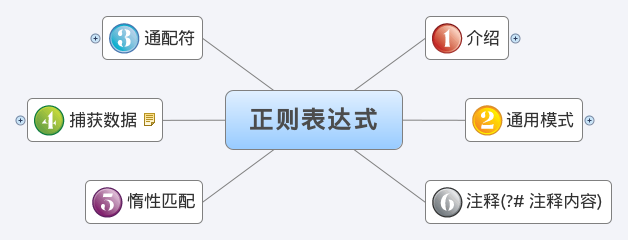思维导图 ? ?点击下图,可以看具体内容!

$regex = '/^http:\/\/([\w.]+)\/([\w]+)\/([\w]+)\.html$/i';
$str = 'http://www.youku.com/show_page/id_ABCDEFG.html';
$matches = array();
?
if(preg_match($regex, $str, $matches)){
????var_dump($matches);
}
?
echo "\n";
??? preg_match中的$matches[0]将包含与整个模式匹配的字符串。?
??? 使用"#"定界符的代码如下.这个时候对"/"就不转义!
?$regex = '#^http://([\w.]+)/([\w]+)/([\w]+)\.html$#i';
$str = 'http://www.youku.com/show_page/id_ABCDEFG.html';
$matches = array();
?
if(preg_match($regex, $str, $matches)){
????var_dump($matches);
}
?
echo "\n";
??¤ 修饰符:用于改变正则表达式的行为。
???? 我们看到的('/^http:\/\/([\w.]+)\/([\w]+)\/([\w]+)\.html/i')中的最后一个"i"就是修饰符,表示忽略大小写,还有一个我们经常用到的是"x"表示忽略空格。
贡献代码:
?
?$regex = '/HELLO/';
$str = 'hello word';
$matches = array();
?
if(preg_match($regex, $str, $matches)){
????functions" style="border-top-left-radius: 0px !important; border-top-right-radius: 0px !important; border-bottom-right-radius: 0px !important; border-bottom-left-radius: 0px !important; background-image: none !important; background-color: initial !important; float: none !important; height: auto !important; line-height: 2em !important; vertical-align: baseline !important; width: auto !important; white-space: pre-wrap; color: #ff1493 !important; padding: 0px !important; margin: 0px !important;">echo 'No i:Valid Successful!',"\n";
}
?
if(preg_match($regex.'i', $str, $matches)){
????echo 'YES i:Valid Successful!',"\n";
}
?
? ¤ 字符域:[\w]用方括号扩起来的部分就是字符域。
? ¤ 限定符:如[\w]{3,5}或者[\w]*或者[\w]+这些[\w]后面的符号都表示限定符。现介绍具体意义。
???? {3,5}表示3到5个字符。{3,}超过3个字符,{,5}最多5个,{3}三个字符。
???? * 表示0到多个
???? + 表示1到多个。
? ¤ 脱字符号
????? ^:
????????? > 放在字符域(如:[^\w])中表示否定(不包括的意思)——“反向选择”
????????? >? 放在表达式之前,表示以当前这个字符开始。(/^n/i,表示以n开头)。
????? 注意,我们经常管"\"叫"跳脱字符"。用于转义一些特殊符号,如".","/"
?
通配符(lookarounds):断言某些字符串中某些字符的存在与否! ? lookarounds分两种:lookaheads(正向预查 ?=)和lookbehinds(反向预查?<=)。 > 格式: 正向预查:(?=) 相对应的 (?!)表示否定意思 反向预查:(?<=) 相对应的 (?<!)表示否定意思 前后紧跟字符 ?$regex = '/(?<=c)d(?=e)/';? /* d 前面紧跟c, d 后面紧跟e*/
$str = 'abcdefgk';
$matches = array();
?
if(preg_match($regex, $str, $matches)){
????var_dump($matches);
}
?
echo "\n";
否定意义:
?$regex = '/(?<!c)d(?!e)/';? /* d 前面不紧跟c, d 后面不紧跟e*/
$str = 'abcdefgk';
$matches = array();
?
if(preg_match($regex, $str, $matches)){
????var_dump($matches);
}
?
echo "\n";
?
>字符宽度:零 验证零字符代码 ?$regex = '/HE(?=L)LO/i';
$str = 'HELLO';
$matches = array();
?
if(preg_match($regex, $str, $matches)){
????var_dump($matches);
}
?
echo "\n";
打印不出结果!
?$regex = '/HE(?=L)LLO/i';
$str = 'HELLO';
$matches = array();
?
if(preg_match($regex, $str, $matches)){
????var_dump($matches);
}
?
echo "\n";
?能打印出结果!
说明:(?=L)意思是HE后面紧跟一个L字符。但是(?=L)本身不占字符,要与(L)区分,(L)本身占一个字符。
? 捕获数据 ? 没有指明类型而进行的分组,将会被获取,供以后使用。 > 指明类型指的是通配符。所以只有圆括号起始位置没有问号的才能被捕捉。 > 在同一个表达式内的引用叫做反向引用。 > 调用格式: \编号(如\1)。 ?$regex = '/^(Chuanshanjia)[\w\s!]+\1$/';???
$str = 'Chuanshanjia thank Chuanshanjia';
$matches = array();
?
if(preg_match($regex, $str, $matches)){
????var_dump($matches);
}
?
echo "\n";
?
> 避免捕获数据 ?? 格式:(?:pattern) ?? 优点:将使有效反向引用数量保持在最小,代码更加、清楚。 ? >命名捕获组 ?? 格式:(?P<组名>) 调用方式 (?P=组名) ?$regex = '/(?P<author>chuanshanjia)[\s]Is[\s](?P=author)/i';
$str = 'author:chuanshanjia Is chuanshanjia';
$matches = array();
?
if(preg_match($regex, $str, $matches)){
????var_dump($matches);
}
?
echo "\n";
运行结果

惰性匹配(记住:会进行两部操作,请看下面的原理部分)
格式:限定符?
???? 原理:"?":如果前面有限定符,会使用最小的数据。如“*”会取0个,而“+”会取1个,如过是{3,5}会取3个。
先看下面的两个代码:
代码1.
?<?php
$regex = '/heL*/i';
$str = 'heLLLLLLLLLLLLLLLL';
if(preg_match($regex, $str, $matches)){
????var_dump($matches);
}
?
echo "\n";
? 结果1.

?
代码2
?<?php
$regex = '/heL*?/i';
$str = 'heLLLLLLLLLLLLLLLL';
if(preg_match($regex, $str, $matches)){
????var_dump($matches);
}
?
echo "\n";
? 结果2

?
代码3,使用“+”
?<?php
$regex = '/heL+?/i';
$str = 'heLLLLLLLLLLLLLLLL';
if(preg_match($regex, $str, $matches)){
????var_dump($matches);
}
?
echo "\n";
?结果3

代码4,使用{3,5}
?<?php
$regex = '/heL{3,10}?/i';
$str = 'heLLLLLLLLLLLLLLLL';
if(preg_match($regex, $str, $matches)){
????var_dump($matches);
}
?
echo "\n";
?结果4

$regex = '/
????^host=(?<!\.)([\d.]+)(?!\.)???????????????? (?#主机地址)
\|
????([\w!@#$%^&*()_+\-]+)?????????????????????? (?#用户名)
\|
????([\w!@#$%^&*()_+\-]+)?????????????????????? (?#密码)
(?!\|)$/ix';
?
$str = 'host=192.168.10.221|root|123456';
$matches = array();
?
if(preg_match($regex, $str, $matches)){
????var_dump($matches);
}
?
echo "\n";
?
? 特殊字符 ? ? 特殊字符 解释 * 0到多次 + 1到多次还可以写成{1,} ? 0或1次 . 匹配除换行符外的所有单个的字符 \w [a-zA-Z0-9_] \s 空白字符(空格,换行符,回车符)[\t\n\r] \d [0-9] ?